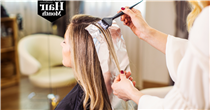Written by Keeks Reid
If you’re about to book in for a first-time balayage, here’s everything you need to know about the most popular colour service in the hair world.
Summer seems to be the season when balayage booms, which makes sense: it’s in line with people lightening their hair in time for the warmer weather. However, the beauty of this technique is that it can be appreciated year-round and, while balayage is most associated with blonde or lighter hair, there’s a lot more breadth to it than you might think.
Even the concept of balayage is widely misunderstood. Take my hair for example – earlier this year I wanted to dye it after being inspired by all the red and copper trends that I was seeing everywhere. My colourist, Lloyd Court at seanhanna in West London, used a French balayage technique to create a shade that was punchy but maintained the depth of my natural hair colour. When people asked about it, I told them it was balayage and was often met with confusion – after all, balayage is for blondes, right? Wrong.
And there’s a whole lot more to this popular technique that’s worth knowing – so here’s everything you need to know about balayage before you book in for your appointment.
What is balayage?
Although it’s often thought of as a hair colour, Balayage is actually a hair colouring technique. “Balayage is a French word, which means ‘balayer’ and translates as ‘to sweep’,” explains award-winning hairdresser Anne Veck. “Hairdressers have been using it since the 1970s, but it started to become more popular in the 1990s.” It’s also referred to as ‘freehand painting’ because of the artistic way dye is layered onto the hair and creates a seamless, blended look.
While balayage is a highlighting technique, it differs from the old-school highlights that we all know and love. “Traditional highlights are applied using foils and placed as close to the root as possible, which results in very noticeable regrowth because there’s an obvious line of colour change,” says Christopher Laird, co-owner of November Collective. Foils are more often used when hairdressers do a heavier colour change or a bolder look, while balayage has much more natural results.
Is balayage just for blondes?
Balayage can be used on any and every hair colour and texture. Blonde hair and balayage go hand in hand because of the depth it can add to mousier tones, but the technique is perfect for adding seamless dimension and more shine to dark hair, too.
“Many clients are now opting for varying colours of balayage throughout the year,” says Veck. “They may choose lighter pieces throughout the summer and then opt for more autumnal shades as we move into the cooler months. Many darker hair clients also choose to have red or purple balayage as well – it works perfectly to add a variety of tones to the overall colour.”
Texture-wise, balayage can enhance the look of curl definition, so if you have curly or coily hair this could be a great choice to add dimension. Just remember that any technique that involves lightening the hair can alter your curl pattern, so always speak with your colourist before you proceed.
How often do you need to retouch balayage?
“The beauty of balayage is that it’s very low-maintenance,” says Laird. “You don’t have the commitment of having to have your roots redone regularly. Some clients only need to visit the salon every six months to have their balayage touched up.”
So, if you’re looking for a low maintenance hair look, you’ve met your match. Personally, I have my balayage topped up once a year because of how well it grows out, and in between appointments I get the colour toned and glossed to make it look fresh. It really is a totally individual choice depending on personal preference and what works for you.
How much does balayage cost in the UK?
The cost of balayage differs from salon to salon and price is also affected by whereabouts in the country you are. However, because it’s a colour service that doesn’t require a lot of in-salon upkeep, it does tend to be one of the more expensive salon services. Prices normally start at around £100, but the length of hair will also come into play because it’ll take longer to achieve the final look.
What the best way to maintain balayage at home?
Like with all hair colouring services, you have to be diligent with aftercare. Choose a shampoo and conditioner specially formulated for coloured hair. Laird says: “I always advise my clients to really think carefully about what their hair needs and work in a prescriptive way to correct any issue. Bleached hair is generally drier, so I’d always recommend adding a replenishing mask into your home care routine to maintain hair health.”
I love L’Oréal Professionnel Serie Expert Metal Detox Anti-Deposit Protector Mask, £26, and Philip Kingsley Elasticizer, £35, for strength and protection. When it comes to styling balayaged hair, Veck recommends using tools like hairdryers, curling tongs, and straighteners on a lower heat setting to avoid damaging the hair and affecting the fresh new colour.
Main image: Getty
Source: Read Full Article

